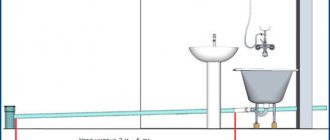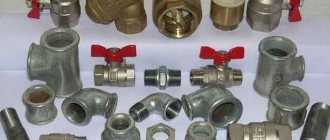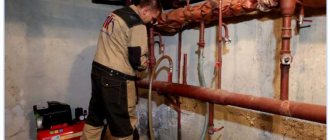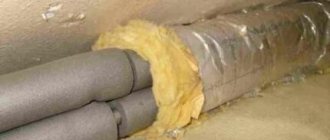An expansion tank is used to balance the autonomous heating system.
Its task is to equalize the volume of coolant heated to high temperatures and maintain a given pressure.
The reliability of performing the functions assigned to this element depends on how correctly its volume is selected.
This parameter is not a constant and depends on specific conditions. Below we will look at how to calculate an expansion tank for a closed heating system.
Principle of operation
To compensate for the expansion of the coolant and maintain the system pressure at the operating level (what it should be can be found in the article), it is necessary to install an expansion tank in it. When heated, part of the liquid exceeding the internal volume of the system enters it, and after the temperature decreases, it flows back.
Depending on the equipment included in the heating network, its size and a number of other factors, open or closed type expanders are used to receive excess coolant. They differ in design and installation method, however, their main characteristic is the volume of coolant that they can accommodate. The tank must contain all the excess coolant that will be released from the system at maximum heating.
Calculation of required volume
Before installing an expansion tank in the heating system, you need to select its size. First you need to calculate the volume of water that the heating system holds. We get this volume by adding up the volumes of all heating devices and pipelines. Data on the devices is in their documentation, and the volume of pipes can be calculated using the data from the table. The volume of one meter of pipe, depending on its size and material, is the following values (in liters).
Multiplying these values by the total length of the network, we obtain the internal volume of pipelines in the system.
Then the required expander is selected according to the table, depending on the resulting volume of the system and the calculated pressure in it.
Table for selecting an expander depending on the volume and design pressure of the system
The table is prepared for networks containing water. If you are going to install an expansion tank in a heating system with anti-freeze, then the resulting internal volume must be multiplied by the correction factor, calculated as the ratio of the density of water to the density of the antifreeze used.
If, when calculating the volume of the expansion tank for heating, the initial data falls between the table indicators, then the nearest larger value is selected.
Types of expanders
Heating in an individual home involves the use of two types of tanks:
- open;
- closed.
Open expanders are installed at the highest point of the heating network and represent a leaky container. It can be made of almost any material, because it is not subject to pressure and is intended only to receive coolant. The only requirement is to maintain the temperature of the coolant without losing its shape.
Closed tanks are manufactured in the form of a sealed cylinder, divided into two parts by a movable membrane. One contains gas pumped under pressure, and the other is designed to receive coolant. After cooling the coolant, the compressed gas squeezes it back into the heating.
In addition to the main task of neutralizing excess pressure, open expanders are designed to remove air from the network and replenish various water losses (evaporation, leaks, etc.).
An expansion tank for an open heating system can be made of various materials and have different shapes, because it is not faced with the task of withstanding internal pressure. It is placed at its highest point and is equipped with a lid for adding water, ease of maintenance and protection from contamination.
In addition to neutralizing excess pressure, open expanders are designed to remove air from the network and replenish various water losses
If the height of the building makes it possible to place an expansion tank for heating in the residential part, for example, on the second or third floors, then it can be placed in the bathroom or toilet, or a separate room can be allocated for it. Otherwise, the expander will have to be placed in the attic and reliably insulated.
The coolant that moves through the pipes of the heating system is practically not compressed. Otherwise, the pressure in the line may jump sharply, which will lead to an emergency. Heating water in the range of 20 °C – 90 °C is accompanied by its expansion. That is why the heating system needs a special tank, into which excess coolant enters after its volume increases.
Thus, all components and devices will work correctly without interruptions and accidents. Considering the important role assigned to this element of the circuit, the calculation of the expansion tank for heating should be carried out in accordance with established rules.
Types of tanks
The heating system can be equipped with one of the types of expansion tanks.
How to choose the right element of the heating system in each individual case? This will be discussed further.
Open type
As the name suggests, an open-type tank is a container with an open top into which coolant can be added. It does not require locking parts, a membrane partition or a lid. But due to the fact that water evaporates in such a container, and its quantity must be constantly monitored (topped up), open-type tanks are gradually being abandoned.
In addition, such heating is characterized by low pressure, and the tank itself is often subject to corrosion. Therefore, today more modern closed-type containers are installed.
Closed type
Closed expansion tanks (diaphragms) are installed in lines with a circulation pump. The highest quality samples are produced in the form of a sealed red container with a rubber membrane inside. Their membrane is made of more durable technical rubber.
Products for hot water supply, the body of which is painted blue, have a lower quality rubber (it is food grade). Such models can withstand pressure less well and wear out faster.
In addition to the main function - compensation of the coolant volume when the temperature drops and its intake during expansion from heating, the membrane controls the liquid level in the heating line, removes air from the system, drains water into the sewer when there is an excess volume and acts as a buffer zone during a pressure surge.
Equipment and principle of operation
The expansion tank, in addition to the housing, includes a membrane (cylinder or diaphragm), the upper part of which is filled with inert gas or air. The lower compartment of the sealed container is intended for coolant.
Along with an increase in temperature, the water expands, and the excess mass of the coolant enters the membrane. The volume of the chamber with air decreases, and the pressure in this part increases, compensating for the pressure in the line. When the coolant temperature decreases, the reverse process is observed.
The expansion tank can be equipped with a replaceable (flange) or permanent membrane. The second type of product is cheaper.
The membrane in the tank is pressed tightly against the inner wall, since its entire volume is filled with gas.
When water gets inside, the pressure increases. At the moment the heating starts, there is a risk of damage to the diaphragm from a pressure surge, and then the pressure gauge gradually changes the readings and the integrity of the part is out of danger.
To avoid damage to the membrane, it is necessary to install a pressure gauge safety valve that reacts to increased pressure (for private houses the norm is from 3.5 to 4 bar).
Advantages of the flange model
The advantages of flanged devices include the following characteristics:
- withstands greater pressure inside the system than a device with a constant diaphragm;
- it is possible to replace the membrane if it is damaged;
- horizontal and vertical installation of the device.
Selection of device according to calculation
Before you start calculating the membrane, you need to know that the larger the volume of the heating system and the higher the maximum temperature index of the coolant, the larger the volume of the tank itself should be.
There are several ways to carry out the calculation: contacting specialists at a design office, performing the calculations yourself using a special formula, or calculating using an online calculator.
Formula
The calculation formula looks like this: V = (VL x E) / D, where:
- VL – volume of all main parts, including the boiler and other heating devices;
- E – coefficient of expansion of the coolant (in percent);
- D – membrane efficiency indicator.
Determination of volume
The easiest way to determine the average volume of a heating system is by the power of the heating boiler at the rate of 15 l/kW. That is, with a boiler power of 44 kW, the volume of all system lines will be equal to 660 l (15x44).
The expansion coefficient for a water system is approximately 4% (at a coolant temperature of 95 °C).
If antifreeze is poured into the pipes, then they resort to the following calculation:
- 10% - 4% x 1.1 = 4.4%;
- 20% - 4% x 1.1 = 4.8%, etc.
The efficiency rating (D) is based on the initial and maximum pressure in the system, as well as the starting air pressure in the chamber. The safety valve is always set to maximum pressure. To find the value of the efficiency indicator, you need to carry out the following calculation: D = (PV - PS)/(PV+1), where:
- PV is the maximum pressure mark in the system, for which the indicator is 2.5 bar;
- PS – the charging pressure of the membrane is usually 0.5 bar.
Now it remains to collect all the indicators into the formula and get the final calculation:
- VL = 15x44=660 l;
- D = (2.5 – 0.5) / (2.5+1) = 0.58;
- E = 4% = 0.04;
- V = (660×0.04) / 0.58 = 45.5 l.
You can round up the resulting number and choose an expansion tank model starting from 46 liters. If water is used as a coolant, the volume of the tank will be at least 15% of the capacity of the entire system. For antifreeze this figure is 20%. It is worth noting that the volume of the device may be slightly larger than the calculated number, but in no case less.
Any heating system has a number of important characteristics - rated thermal power, fuel consumption and volume of components. Calculating the latter indicator requires a careful and comprehensive approach. How to make a correct calculation of volumes for heating: water, tanks, coolant and other system components?
Calculation of the expansion tank for a system with a 31 kW boiler
Construction of a gas boiler with a built-in expansion tank
Before making calculations for selecting an expansion tank, you should know that most wall-mounted boilers are equipped with built-in expansion tanks. The volume of the built-in tank is indicated in the technical documentation of the boiler. When recalculating the volume of the heating system based on the boiler power (by multiplying 1 kW of heat power by 15 liters), the tank’s compliance with the volume of the system being constructed is checked. If there is a shortage, an additional tank is installed. Its volume is calculated minus the built-in expansion machine. Floor-standing boilers, as a rule, do not have built-in equipment.
The calculation looks like this:
K = (DM – DB)/(DM+1) = (3.0 – 1.5)/(3.0 – 1) = 0.375
3.0 – pressure in the system, maximum, atm.;
1.5 – air pressure behind the membrane, atm;
Heating calculation required
First, you should determine the relevance of calculating the volume of water in the heating system or the same indicator for batteries and an expansion tank. After all, you can install these components without complex operations, guided only by personal experience and advice from professionals.
The operation of any heating system is associated with a constant change in the coolant parameters - temperature and pressure in the pipes. Therefore, calculating heating according to the volume of the building will allow you to correctly equip the heat supply based on the characteristics of the house. In addition, the direct dependence of operating efficiency on current steam meters should be taken into account. Since you can calculate the volume of water in the heating system yourself, this procedure is recommended to be performed to avoid the following situations:
- Incorrect actual thermal operating conditions that do not correspond to the calculated ones;
- Uneven heat distribution across heating appliances;
- Occurrence of emergency situations. After all, how can you calculate the volume of an expansion tank for heating if the total capacity of the pipelines and batteries is not known?
To minimize the occurrence of these situations, the volume of the heating system and its components should be calculated in a timely manner.
Calculations of heat supply parameters are carried out even before installation work. They serve as the basis for the selection of components.
Calculation of coolant volume in pipes and boiler
The starting point for calculating the technical characteristics of the components is the calculation of the volume of water in the heating system. In fact, it is the sum of the capacity of all elements, from the boiler heat exchanger to the batteries.
How to calculate the volume of a heating system yourself, without involving specialists or using special programs? To do this, you will need a diagram of the location of the components and their overall characteristics. The total capacity of the system will be determined by these parameters.
Volume of water in the pipeline
A significant part of the water is located in pipelines. They occupy a large part in the heat supply scheme. How to calculate the volume of coolant in a heating system, and what characteristics of pipes do you need to know for this? The most important of them is the diameter of the line. It is he who will determine the water capacity in the pipes. To calculate, just take the data from the table.
Pipes of various diameters can be used in the heating system. This is especially true for collector circuits. Therefore, the volume of water in the heating system is calculated using the following formula:
Vtotal=Vtr1*Ltr1+ Vtr2*Ltr2+ Vtr2*Ltr2…
Where Vtotal
– total water capacity in pipelines, l,
Vtr
– volume of coolant in 1 m.p.
pipes of a certain diameter, Ltr
- the total length of the pipeline with a given cross-section.
For plastic pipes, the diameter is calculated based on the dimensions of the outer walls, and for metal pipes, based on the inner walls. This can be significant for thermal systems with a large extent.
Calculation of heating boiler volume
The correct volume of the heating boiler can only be determined from the technical data sheet. Each model of this heating device has its own unique characteristics, which are often not repeated.
A floor-standing boiler can have large dimensions. This is especially true for solid fuel models. In fact, the coolant does not occupy the entire volume of the heating boiler, but only a small part of it. All liquid is located in a heat exchanger - a structure necessary to transfer thermal energy from the fuel combustion zone to water.
If the instructions from the heating equipment have been lost, the approximate capacity of the heat exchanger can be taken for calculations. It depends on the power and model of the boiler:
- Floor-standing models can hold from 10 to 25 liters of water. On average, a 24 kW solid fuel boiler contains about 20 liters in the heat exchanger. coolant;
- Wall-mounted gas ones are less spacious - from 3 to 7 liters.
Taking into account the parameters for calculating the volume of coolant in the heating system, the capacity of the boiler heat exchanger can be neglected. This figure varies from 1% to 3% of the total heat supply to a private home.
Without periodic heating cleaning, the cross-section of the pipes and the flow diameter of the batteries are reduced. This affects the actual capacity of the heating system.
Boiler - which one to choose
Since the closed heating system of a private house can operate autonomously, it makes sense to install a heating boiler with automation. In this case, having configured the parameters, you do not need to return to this. All modes are supported without human intervention.
The most convenient gas boilers in this regard. They have the ability to connect a room thermostat. The temperature set on it is maintained with an accuracy of one degree. It dropped by a degree, the boiler turned on, heating the house. As soon as the thermostat is activated (the temperature is reached), the operation stops. Comfortable, convenient, economical.
Some models have the ability to connect weather-dependent automation - these are external sensors. Based on their readings, the boiler adjusts the power of the burners. Gas boilers in closed heating systems are good equipment that can provide comfort. The only pity is that gas is not available everywhere.
Two-pipe closed heating system in a house on two floors (diagram)
Electric boilers can provide a no less degree of automation. In addition to traditional units, induction and electrode units have recently appeared on heating elements. They are distinguished by their compact size and low inertia. Many believe that they are more economical than boilers using heating elements. But even this type of heating unit cannot be used everywhere, since power outages in winter are a common occurrence in many regions of our country. And provide the boiler with electricity. 8-12 kW from the generator is a very difficult matter.
Solid or liquid fuel boilers are more versatile and independent in this regard. An important point: to install a liquid fuel boiler, a separate room is required - this is a requirement of the fire service. Solid fuel boilers can be installed in the house, but this is inconvenient, since a lot of debris falls from the fuel during combustion.
Modern solid fuel boilers, although they remain periodic equipment (they warm up during combustion and cool down when the fuel burns out), but they also have automation that allows you to maintain a given temperature in the system, regulating the intensity of combustion. Although the degree of automation is not as high as that of gas or electric boilers, it is there.
Example of a closed heating system with an induction boiler
Pellet boilers are not very common in our country. In fact, this is also solid fuel, but boilers of this type operate in continuous mode. Pellets are automatically fed into the firebox (until the stock in the burner is finished). If the fuel quality is good, ash cleaning is required once every few weeks, and all operating parameters are controlled automatically. The only thing holding back the spread of this equipment is its high price: the manufacturers are mainly European, and their prices are corresponding.
A little about calculating boiler power for closed-type heating systems. It is determined according to the general principle: per 10 sq. meters of area with normal insulation take 1 kW of boiler power. It’s just not recommended to take it “back to back”. First, there are unusually cold periods during which you may not have enough rated power. Secondly, working at the power limit leads to rapid wear of the equipment. Therefore, it is advisable to take the boiler power for the system with a margin of 30-50%.
Calculation of the volume of the heating expansion tank
For safe operation of the heating system, it is necessary to install special equipment - an air vent, a drain valve and an expansion tank. The latter is designed to compensate for the thermal expansion of hot water and reduce the critical pressure to normal levels.
Closed tank
The actual volume of the expansion tank for the heating system is not constant. This is due to its design. For closed heat supply circuits, membrane models are installed, divided into two chambers. One of them is filled with air with a certain pressure indicator. It should be 10% -15% less than the critical value for the heating system. The second part is filled with water from a pipe connected to the main line.
To calculate the volume of the expansion tank in the heating system, you need to find out its filling coefficient (Kzap). This value can be taken from the table data:
In addition to this indicator, you will need to determine additional:
- The normalized coefficient of thermal expansion of water at a temperature of +85°C, E – 0.034;
- Total volume of water in the heating system, C;
- Initial ( Pmin
) and maximum (
Pmax
) pressure in the pipes.
Further calculations of the volume of the expansion tank for the heating system are performed using the formula:
If antifreeze or other non-freezing liquid is used in heat supply, the value of the expansion coefficient will be 10-15% higher. According to this method, it is possible to calculate with great accuracy the capacity of the expansion tank in the heating system.
The volume of the expansion tank cannot be included in the total heat supply. These are dependent quantities that are calculated in strict order - first the heating, and only then the expansion tank.
Open expansion tank
To calculate the volume, you can use a less labor-intensive method. Fewer requirements are placed on it, since in fact it is necessary to control the coolant level.
The main value is the thermal expansion of water as its degree of heating increases. This figure is 0.3% for every +10°C. Knowing the total volume of the heating system and the thermal operating conditions, you can calculate the maximum volume of the tank. It should be remembered that it can only be 2/3 filled with coolant. Let's assume that the capacity of the pipes and radiators is 450 liters, and the maximum temperature is +90°C. Then the recommended volume of the expansion tank is calculated using the following formula:
Vtank=450*(0.003*9)/2/3=18 liters.
If the open expansion tank performs the functions of monitoring the coolant level, its maximum filling level is determined by the installed additional side pipe.
With bottom or top position
There are three options for connecting a storage tank and using the water supply:
- Top location of the container. In this case, water is drawn under the influence of gravity. The higher the accumulator is located in relation to the consumer, the stronger the water pressure. Every 10 meters of height adds 0.1 atmosphere, or approximately 1 bar.
- Bottom location of a simple storage tank. Gravity will no longer help, and a pump is used to supply it to the water supply system, raising the pressure to the optimal level.
- Membrane-type storage tanks themselves create the required pressure for water supply. A lower location at the consumer level is optimal for them, since there will be no advantage from installing in an attic or tower.
How to determine the best option?
If a house has several floors and it is possible to place a storage tank in the attic, then this will eliminate the need for additional installation of a pump, and there is no need to spend money on an expensive membrane tank. In fact, this is an analogue of a water tower. However, raise the container so high as to ensure a comfortable pressure of 2-2.5 atm. it's still difficult. Moreover, the question arises of insulating the tank so that the water in it does not freeze in winter.
In the event of an emergency shutdown of water, the existing pressure is 0.2-0.3 atm. It will be quite enough to use the faucet in the sink, toilet or even shower, but it will not be possible to use some household appliances, such as a washing machine or dishwasher, which require more pressure to operate the solenoid valves.
Installing the tank at the same level as the consumer is suitable in cases where it is not possible to raise the tank to the attic or at least to a higher floor. The same applies to installing a storage tank in an apartment. You will need a small pump to supply water under pressure to the water supply. To ensure adequate operation, the pump will require a diaphragm expansion tank.
A storage tank with a membrane is perfect for storing water reserves both when using a centralized water supply system and in an autonomous system. However, it does not require additional equipment or overhead location. However, its cost is significantly higher than any conventional storage tank, even in combination with a simple pump.
Calculation of the volume of radiators and radiators
To perform an accurate calculation, you need to know the volume of water in the heating radiator. This indicator directly depends on the design of the component, as well as its geometric parameters.
Just as when calculating the volume of a heating boiler, the liquid does not fill the entire volume of the radiator or battery. For this purpose, the design has special channels through which the coolant flows. Correct calculation of the volume of water in a heating radiator can only be performed after obtaining the following device parameters:
- Center-to-center distance between forward and return pipelines to batteries. It can be 300, 350 or 500 mm;
- Material of manufacture. In cast iron models, the filling with hot water is much greater than in bimetallic or aluminum ones;
- Number of sections in the battery.
It is best to find out the exact volume of water in the heating radiator from the technical data sheet. But if this is not possible, you can take approximate values into account. The greater the interaxial distance of the battery, the larger the volume of coolant it will hold.
To calculate the total volume of water in a heating system with panel metal radiators, you should find out their type. Their capacity depends on the number of heating planes - from 1 to 2:
- For type 1 battery, for every 10 cm there is 0.25 volume of coolant;
- For type 2, this figure increases to 0.5 liters per 10 cm.
The result obtained must be multiplied by the number of sections or the total length of the radiator (metal).
To correctly calculate the volume of a heating system with designer radiators of non-standard shape, you cannot use the above described method. Their volume can only be obtained from the manufacturer or its official representative.
Features of tanks manufactured using different technologies
Containers made of structural polymers (polyethylene, polypropylene, polystyrene, polyvinyl chloride plastic compound, ethylene copolymers) are made from:
- sheet blanks using welding methods (resistance butt, lap, T-welding) and thermoforming (simplified by extrusion, stamping of a heated sheet);
- granules or powder by blow and rotational molding.
Conventionally, one-piece “seamless” tanks are manufactured using thermal blowing and rotational molding technologies, which have their own advantages and disadvantages, summarized in the table below.
Water tanks made by connecting individual structural elements by butt welding, overlapping, have lower strength compared to rotomolding, which is taken into account by using the correction factor ϕsh in the calculations, which ranges from 0.35 and 0.4 for vinyl plastic and polystyrene (respectively) to 0.9 for polyethylene. The strength (coefficient 1.0) is not reduced only for tanks manufactured using “seamless” rotomoulding technology, essentially solid cast.
Calculation of the volume of a heat accumulator
In some heating systems, auxiliary elements are installed, which can also be partially filled with coolant. The most capacious of them is the thermal accumulator.
The problem in calculating the total volume of water in the heating system along with this component lies in the configuration of the heat exchanger. In fact, the heat accumulator is not filled with hot water from the system - it serves to heat it from the liquid in it. For correct calculations, you need to know the design of the internal pipeline. Alas, manufacturers do not always indicate this parameter. Therefore, you can use an approximate calculation method.
Before installing the heat accumulator, its internal pipeline is filled with water. Its quantity is calculated independently and taken into account when calculating the total heating volume.
If the heating system is modernized, new radiators or pipes are installed, it is necessary to perform an additional recalculation of its total volume. To do this, you can take the characteristics of new devices and calculate their capacity using the methods described above.
As an example, you can familiarize yourself with the method for calculating an expansion tank:
Expansion tank calculation
are performed to determine its volume, the minimum diameter of the connecting pipeline, the initial pressure of the gas space and the initial operating pressure in the heating system.
The method for calculating expansion tanks is complex and routine, but in general it is possible to establish the following relationship between the volume of the tank and the parameters influencing it:
- The larger the capacity of the heating system, the larger the volume of the expansion tank.
- The higher the maximum water temperature in the heating system, the larger the tank volume.
- The higher the maximum permissible pressure in the heating system, the smaller the volume.
- The smaller the height from the installation site of the expansion tank to the top point of the heating system, the smaller the tank volume.
Since expansion tanks in the heating system are necessary not only to compensate for the changing volume of water, but also to replenish minor coolant leaks, a certain supply of water, the so-called operating volume, is provided in the expansion tank. The above calculation algorithm assumes an operational water volume of 3% of the heating system capacity.
Selection of coolant
Water is most often used as a working fluid for heating systems. However, antifreeze can be an effective alternative solution. Such a liquid does not freeze when the ambient temperature drops to a critical level for water. Despite the obvious advantages, the price of antifreeze is quite high. Therefore, it is used mainly for heating small buildings.
Filling heating systems with water requires preliminary preparation of such a coolant. The liquid must be filtered from dissolved mineral salts. For this purpose, specialized chemical reagents that are commercially available can be used. Moreover, all air must be removed from the water in the heating system. Otherwise, the efficiency of space heating may decrease.
Selection of expansion tanks
Selection of expansion tank
should be carried out taking into account its temperature and strength characteristics. The pressure and temperature at the tank connection point must not exceed the maximum permissible values.
The volume of the expansion tank must be greater than or equal to the volume obtained as a result of the calculation. There are no negative consequences from overestimating the volume beyond the calculated one.
If the installation of expansion tanks is planned indoors, then it should be taken into account that vessels with a diameter of more than 750 mm and a height of more than 1.5 m may not fit through the doorway, and mechanization will be required to move them. In this case, it is better to give preference not to one, but to several membrane tanks of smaller capacity.
Attention!
1. When using glycol mixtures as a coolant, it is recommended to select an expansion tank with a volume 50% larger than the design one.
2. The first sign of an incorrectly calculated expansion tank or its unfulfilled adjustment is the frequent operation of the safety valve.
The operation of the heating system is often associated with extreme pressure increases and the presence of hydraulic shocks. All this can lead to breakdown of expensive equipment and rapid wear of key elements of the system (such as, for example, a boiler). In order to protect the heating system, special compensating tanks are used. What are they, what types of tanks exist, and how to choose a device - read below.
General connection rules
A water tank is installed on a prepared site: a concrete base tied to the foundation, or a reinforced metal frame made of profiled pipe. The design must withstand one and a half weight of the tank and the water in it when completely filled.
The inlet pipe can be of any suitable diameter, water is supplied under pressure. The outlet pipe and pipe to the water supply system are chosen with a diameter one and a half to two times larger than the cross-section of the main line. The optimal size is 32 mm.
Even the best quality insulation only slows down the decrease in temperature in the tank. To prevent water from freezing when installing the tank in an unheated attic or on the roof, you should use any suitable heating system for the pipes and the tank itself.
Why do you need an expansion tank?
The expansion tank is one of the most important elements of the heating system, which helps to extend its service life. The absence of this element in heating systems can lead to rupture of pipes, breakdown of taps and other components. The expansion tank performs several important tasks.
So, an expansion tank is needed in order to compensate for the temperature in the system.
Expansion when heated is characteristic of all liquids and materials. The volume of coolant can double due to thermal expansion. This, in turn, increases the pressure in the heating system. The expansion device, in this case, pushes out the coolant, equalizing the pressure.
In addition, the expansion tank serves to protect the system from the harmful effects of hydraulic shocks.
This is due to the fact that the pump can be turned off and on. At the same time, the pressure in the system rises sharply, which can lead to water hammer. The expansion tank, in turn, compensates for this shock.
Expansion tanks are well suited for installation in systems:
- Closed loop;
- Heating powered by solar batteries or;
- Independent systems connected to central heating.
There are several types of expanders that are suitable for a particular type of system. You can make a tank yourself. Some craftsmen have adapted a receiver for a homemade tank.
What features does an expansion tank for open heating have?
The open-type expansion (compensation) tank is designed simply: it is a simple-shaped tank with a lid on top. This design is rarely used in heating systems. This is due to the lack of tightness of the container: water can be added to the system by opening the top lid of the tank. At the same time, air enters the system, which leads to the formation of rust in it. In addition, due to evaporation there is a large loss of coolant.
However, installing such a tank allows you to solve many problems:
- Allows you to remove excess air from the system;
- Protects the system from debris and dust getting inside.
An open type tank should be placed at the highest point of the circuit. You can place the tank on the return line: this will reduce heat loss and abundant evaporation of the coolant. But, in this case, a design should be provided for water drainage: when the pressure increases, water will be pushed out through the tank lid, flooding the floor and everything located within the radius of the device. If the water is diverted into a special container, this will significantly reduce coolant losses.
What is the difference between an expansion tank for closed type heating?
The closed device is a sealed tank made of steel with an internal rubber partition. One part of the tank is allocated for filling with water, and the second - with nitrogen or air. When the pressure increases (when the coolant heats up), the rubber partition stretches and the water is pushed into the part with air. A cross-sectional diagram of its structure can help you understand how a tank works.
Depending on the type of membrane, closed tanks are divided into the following types:
- Balloons;
- Diaphragm.
A closed-type membrane compensation tank with a balloon partition is considered more reliable. It also has a larger volume. The partition in the form of a diaphragm, if it is worn out, cannot be replaced.
In heating systems, a membrane tank can perform the following functions:
- Allows you to make the system more flexible and easily manageable;
- Prevents air from entering the system and spreading through the pipes (protects pipes from rust formation);
- Provides minimal heat loss;
In addition, repairing a balloon membrane tank can be easily done with your own hands.
Recommendations from experts
A closed expansion tank does not have to be installed at the highest point of the system.
The main advantage of membrane expansion joints lies precisely in the possibility of placing it in the place most convenient for installation and operation.
Small tanks with a volume of 20-25 liters are usually installed in systems with a circulation pump whose power is 1.2 kW. Increasing the capacity to 20-60 liters will lead to an increase in pump power to 2.0 kW.
There are compensating devices with a volume of 100-200 liters on sale. In addition to their direct purpose, they can play the role of a storage tank for warm water. True, they can be used in this way only if the main source of hot water is turned off for a short period of time.
The standard sizes of expansion tanks cover a fairly wide range. Among them there are models with dimensions so large that standard doorways do not allow them to be brought inside the room. In such a situation, it is better to replace one huge container with several small ones. The main thing is that their total volume is equal to the calculated one.
Choosing expansion tanks for a closed heating system
The selection of a compensation tank should be carried out taking into account the quality of the metal, the resistance of the device to the penetration of one substance into another, the type of membrane and the possibility of its replacement, the range of operating temperatures, the estimated service life of the device (the warranty period from the manufacturer may be indicative in this case).
In order to choose a high-quality and efficient tank, you must follow these recommendations:
- It is better to choose membrane systems that are reliable, effectively cope with their tasks and can be repaired.
- For the production of the membrane, natural butyl rubber or ethylene-propylene rubber must be used.
- If the tank will be included in a system with centralized heating, then the membrane must have increased resistance to high temperatures and damage.
- For an autonomous heating system in a private home, tanks with an elastic membrane are suitable.
- If the tank will be used not only as a device to protect the heating system, but also the water supply, the membrane should be made of food-grade rubber (usually such tanks are painted blue).
Before purchasing a tank, make sure that the calculated pressure values in the boiler and compensator match, and check whether the membrane meets quality and hygiene standards. You can make the selection with the help of a consultant in the store, clearly articulating your requirements.
Calculation of an expansion tank for a closed heating system
The calculation of the compensating tank for the heating system is done in order to determine its volume. It depends on this how well the device will cope with the tasks assigned to it. In addition, in addition to the volume, the minimum diameter of the pipeline for connecting the device and the levels of initial operating pressure in the system are also calculated. The technology for calculating tanks is quite complex and has many nuances.
Therefore, when making calculations, the following correlation should be observed between the volume of the tank and the operational characteristics of the system:
- The higher the maximum temperature exponents of the coolant, the larger the tank size should be;
- If the heating circuit holds a large volume, then a large compensation tank is needed;
- The higher the operating pressure in the system, the smaller the tank is needed;
- The shorter the distance from the installation site of the device to the highest point in the system, the less tank is needed.
There are many methods and formulas for calculating tank sizes.
How to calculate the volume of a cylinder
- First you need to choose through which initial quantities the calculations will be made. In order to find the volume of a cylinder, you need to know its height, as well as its radius, diameter or base area. Each method uses its own formula.
- Next, you need to enter the initial values and units of measurement of the initial values.
- The result will be rounded to the specified decimal place.
- The volume of a cylinder can be expressed in mm3, cm3, dm3, m3 and liters.
- The “calculate” button performs calculations according to the specified condition.
We calculate the volume of the expansion tank for a closed heating system
The volume of the compensation tank is one tenth of the volume of coolant in the heating circuit. According to some data, the volume of the tank for the water system is 15% of the volume of the coolant, with antifreeze - 20%. As a rough calculation, you can take every fifteen liters of tank for every 1000 watts of boiler heat output. You can calculate the size of the tank in more detail.
To do this, you need to know a number of factors such as:
- Temperature range in which the system will operate;
- Coolant volume in the system;
- The degree of increase in coolant volume;
- The height of the tank in the system;
- The degree of reserve of the tank (on average is .2%).
The degree of expansion of the coolant can be found in physical tables: it is constant and depends on the temperature range. The volume of the tank will be equal to the product of the volume of the expanded liquid and the volume of the reserve. In addition, you can find the volume using special online calculators. It should be remembered that the obtained value is an approximate value. It is better to choose a tank by volume with a reserve.
If, after installing the tank, the pressure in the system is released too often, it means you miscalculated the volume of the tank, taking less than it should.
However, it is not necessary to change the vacuum expander for heating. To solve the problem, you will need to purchase another, small device and connect it in parallel.
Eventually
As you can see, calculating the heating capacity comes down to calculating the total value of the four above elements.
Not everyone can determine the required capacity of the working fluid in a system with mathematical accuracy. Therefore, not wanting to perform the calculation, some users act as follows. To begin with, fill the system to approximately 90%, after which the functionality is checked. Next, the accumulated air is released and filling continues.
During operation of the heating system, a natural decline in the coolant level occurs as a result of convection processes. In this case, there is a loss of power and productivity of the boiler. This implies the need to have a reserve tank with working fluid, from where it will be possible to monitor the loss of coolant and, if necessary, replenish it.










